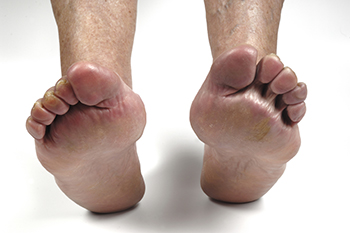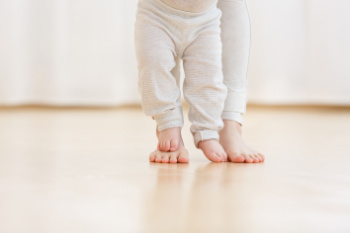Connect With Us
Blog
Items filtered by date: September 2024
How Rheumatoid Arthritis Affects the Feet

Rheumatoid arthritis, or RA, is an inflammatory condition that commonly affects the joints, including those in the feet. People with RA often experience symptoms such as pain, swelling, and stiffness in the smaller joints of the toes and forefoot. Over time, if not properly managed, this can lead to joint deformities, nodules, and even altered foot shape. Foot issues from rheumatoid arthritis can affect mobility and quality of life, making it harder to perform daily activities. A podiatrist can help alleviate discomfort by prescribing custom orthotics, addressing inflammation, and offering treatments to slow joint damage. They can also address associated skin problems, like corns and calluses, which often develop from pressure points on the feet. Early intervention and continuous care are essential to prevent further complications. If you have foot pain related to rheumatoid arthritis, it is suggested that you make an appointment with a podiatrist for an exam, diagnosis, and treatment options.
Because RA affects more than just your joints, including the joints in your feet and ankles, it is important to seek early diagnosis from your podiatrist if you feel like the pain in your feet might be caused by RA. For more information, contact one of our podiatrists of Mt Rose Foot & Ankle Specialists. Our doctors will assist you with all of your podiatric concerns.
What Is Rheumatoid Arthritis?
Rheumatoid Arthritis (RA) is an autoimmune disorder in which the body’s own immune system attacks the membranes surrounding the joints. Inflammation of the lining and eventually the destruction of the joint’s cartilage and bone occur, causing severe pain and immobility.
Rheumatoid Arthritis of the Feet
Although RA usually attacks multiple bones and joints throughout the entire body, almost 90 percent of cases result in pain in the foot or ankle area.
Symptoms
- Swelling and pain in the feet
- Stiffness in the feet
- Pain on the ball or sole of feet
- Joint shift and deformation
Diagnosis
Quick diagnosis of RA in the feet is important so that the podiatrist can treat the area effectively. Your doctor will ask you about your medical history, occupation, and lifestyle to determine the origin of the condition. Rheumatoid Factor tests help to determine if someone is affected by the disease.
If you have any questions, please feel free to contact our office located in Reno, NV . We offer the newest diagnostic and treatment technologies for all your foot care needs.
Causes and Symptoms of Bunions

A bunion, or hallux valgus, occurs when the base joint of the big toe shifts outward, causing the tip of the toe to lean toward the smaller toes. While the exact cause is not fully understood, factors like wearing poorly fitting footwear, a family history of bunions, and joint conditions such as osteoarthritis or rheumatoid arthritis can contribute to their development. Symptoms of bunions include pain, stiffness, and swelling at the big toe joint, which can make walking and finding comfortable shoes difficult. Bunions usually worsen over time, making early treatment important. A podiatrist can evaluate the severity of the bunion and recommend appropriate footwear, prescribe custom orthotics or discuss surgical solutions. These treatments can help alleviate pain, improve foot function, and prevent the condition from worsening. If you have a bunion that is interfering with your daily activities, it is suggested that you schedule an appointment with a podiatrist for an exam and treatment options.
If you are suffering from bunion pain, contact one of our podiatrists of Mt Rose Foot & Ankle Specialists. Our doctors can provide the care you need to keep you pain-free and on your feet.
What Is a Bunion?
Bunions are painful bony bumps that usually develop on the inside of the foot at the joint of the big toe. As the deformity increases over time, it may become painful to walk and wear shoes. Women are more likely to exacerbate existing bunions since they often wear tight, narrow shoes that shift their toes together. Bunion pain can be relieved by wearing wider shoes with enough room for the toes.
Causes
- Genetics – some people inherit feet that are more prone to bunion development
- Inflammatory Conditions - rheumatoid arthritis and polio may cause bunion development
Symptoms
- Redness and inflammation
- Pain and tenderness
- Callus or corns on the bump
- Restricted motion in the big toe
In order to diagnose your bunion, your podiatrist may ask about your medical history, symptoms, and general health. Your doctor might also order an x-ray to take a closer look at your feet. Nonsurgical treatment options include orthotics, padding, icing, changes in footwear, and medication. If nonsurgical treatments don’t alleviate your bunion pain, surgery may be necessary.
If you have any questions, please feel free to contact our office located in Reno, NV . We offer the newest diagnostic and treatment technologies for all your foot care needs.
Common Foot Problems in Children

Children are often active and growing rapidly, which makes them susceptible to a variety of foot problems. Some of the most frequently seen issues include flat feet, plantar warts, ingrown toenails, and Sever’s disease. Flat feet occur when the arches do not develop properly, leading to discomfort or pain, especially during physical activities. Although many children outgrow this condition, some may need supportive footwear or orthotics. Plantar warts, caused by a viral infection, often develop on the soles of the feet and can be painful. These warts are common in children who frequently walk barefoot in public places like pools or locker rooms. Ingrown toenails, where the nail grows into the skin, can cause significant pain and even infection. This is often due to improper nail trimming or wearing tight shoes. Sever’s disease is a common cause of heel pain in growing children, resulting from inflammation of the growth plate in the heel. Rest and proper footwear are key to managing this condition. If your child suffers from a foot problem, it is suggested that you schedule an appointment with a podiatrist, a specialist who treats various conditions related to the feet and ankles.
Making sure that your children maintain good foot health is very important as they grow. If you have any questions, contact one of our podiatrists of Mt Rose Foot & Ankle Specialists. Our doctors can provide the care you need to keep you pain-free and on your feet.
Keeping Children's Feet Healthy
Having healthy feet during childhood can help prevent medical problems later in life, namely in the back and legs. As children grow, their feet require different types of care. Here are some things to consider...
Although babies do not walk yet, it is still very important to take care of their feet.
Avoid putting tight shoes or socks on his or her feet.
Allow the baby to stretch and kick his or her feet to feel comfortable.
As a toddler, kids are now on the move and begin to develop differently. At this age, toddlers are getting a feel for walking, so don’t be alarmed if your toddler is unsteady or ‘walks funny’.
As your child gets older, it is important to teach them how to take care of their feet.
Show them proper hygiene to prevent infections such as fungus.
Be watchful for any pain or injury.
Have all injuries checked by a doctor as soon as possible.
Comfortable, protective shoes should always be worn, especially at play.
If you have any questions, please feel free to contact our office located in Reno, NV . We offer the newest diagnostic and treatment technologies for all your foot care needs.
Why Live with Pain and Numbness in Your Feet?
Causes and Treatment of Claw Toes

Claw toe is a deformity where the toes curl into a claw-like shape due to an imbalance in the muscles and tendons responsible for straightening the toes. The condition often causes the toes to bend upward at the joint closest to the foot and then sharply downward at the middle and third joints, leading to discomfort and the formation of painful calluses. Common causes include nerve damage, foot or ankle trauma, and conditions like diabetes or arthritis. If left untreated, claw toe can worsen over time, making early intervention important. A podiatrist can help manage claw toe by recommending non-invasive treatments such as custom orthotics, toe exercises, and footwear adjustments that provide more room for the toes. In more severe cases, surgery might be necessary to correct the deformity. If you notice a deformity in your toes, it is suggested that you schedule an appointment with a podiatrist for an evaluation and treatment options.
Toe pain can disrupt your daily activities. If you have any concerns, contact one of our podiatrists of Mt Rose Foot & Ankle Specialists. Our doctors can provide the care you need to keep you pain-free and on your feet.
What Causes Toe Pain?
Most severe toe pain is caused due to a sports injury, trauma from dropping something heavy on the toe, or bumping into something rigid. Other problems can develop over time for various reasons.
Toe pain can be caused by one or more ailments. The most common include:
- Trauma
- Sports injury
- Wearing shoes that are too tight
- Arthritis
- Gout
- Corns and calluses
- Hammertoe
- Bunions
- Blisters
- Ingrown toenails
- Sprains
- Fractures (broken bones)
- Dislocations
When to See a Podiatrist
- Severe pain
- Persistent pain that lasts more than a week
- Signs of infection
- Continued swelling
- Pain that prevents walking
Diagnosis
In many cases the cause of toe pain is obvious, but in others, a podiatrist may want to use more advanced methods to determine the problem. These can range from simple visual inspections and sensation tests to X-rays and MRI scans. Prior medical history, family medical history, and any recent physical traumatic events will all be taken into consideration for a proper diagnosis.
Treatment
Treatments for toe pain and injuries vary and may include shoe inserts, padding, taping, medicines, injections, and in some cases, surgery. If you believe that you have broken a toe, please see a podiatrist as soon as possible.
If you have any questions please contact our office located in Reno, NV . We offer the newest diagnostic and treatment technologies for all your foot and ankle needs.
Blog Archives
- September 2025
- August 2025
- July 2025
- June 2025
- May 2025
- April 2025
- March 2025
- February 2025
- January 2025
- December 2024
- November 2024
- October 2024
- September 2024
- August 2024
- July 2024
- June 2024
- May 2024
- April 2024
- March 2024
- February 2024
- January 2024
- December 2023
- November 2023
- October 2023
- September 2023
- August 2023
- July 2023
- June 2023
- May 2023
- April 2023
- March 2023
- February 2023
- January 2023
- December 2022

